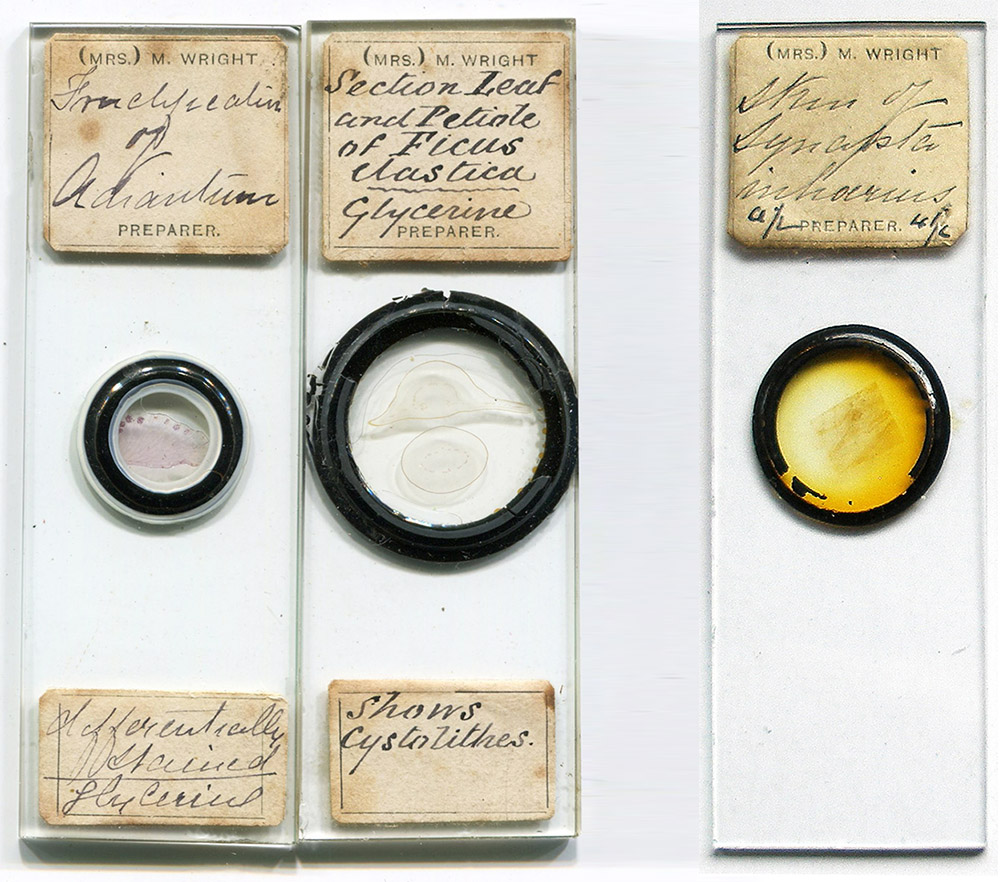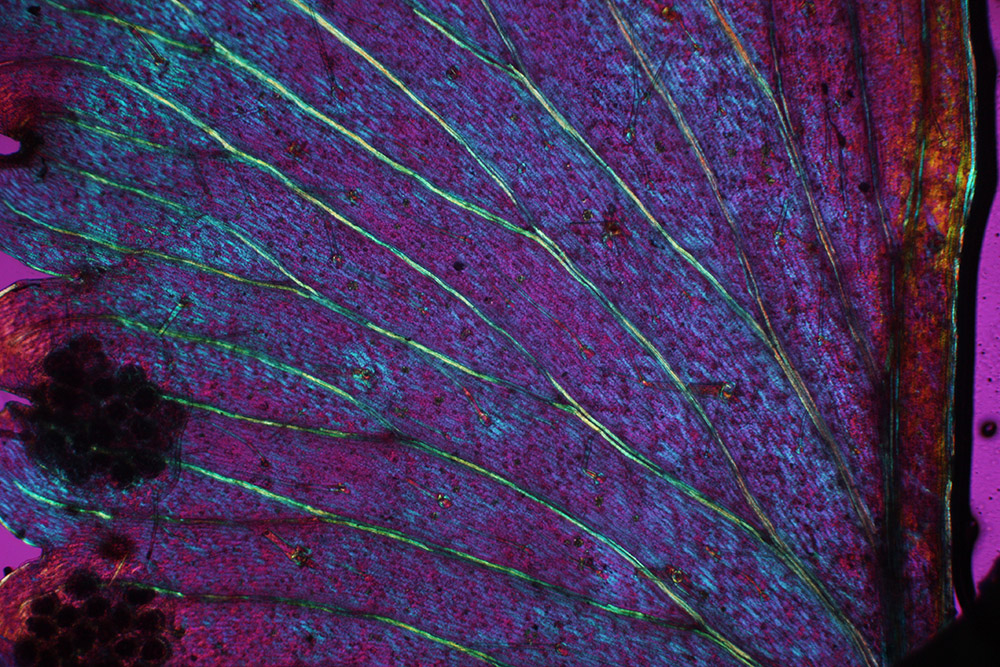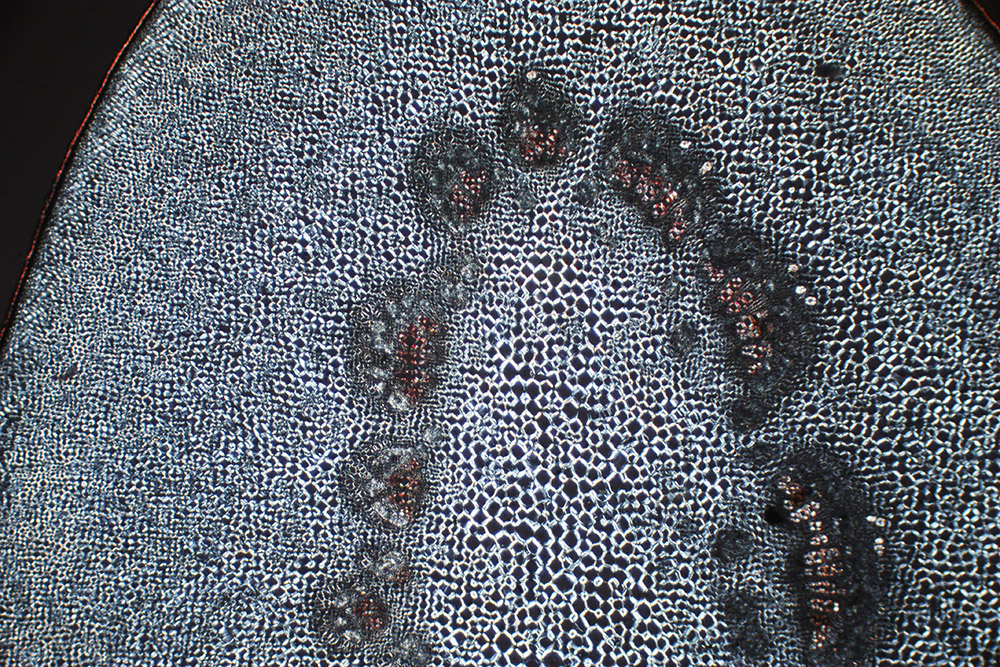
Figure 1. Microscope slides by Mrs. M. Wright. The majority of her slides are of botanical subjects, such as the two slides on the left. A few slides of other topics are known, such as the spicules of Synapta shown on the right.
(Mrs.) M. Wright
by Brian Stevenson
last updated July, 2018
Mrs. M. Wright is an enigma. She produced a fair number of good-quality microscope slides, each with a custom-printed label (Figure 1). Several dozen are known to exist, all of which have originated in England. The vast majority of her preparations are of botanical subjects, although a few other types of specimens are known.
All of her known slides lack paper coverings. She used circular cover slips, sealed with black and/or white ringing cement. Those features suggest production after the 1870s, possibly into the twentieth century.
Her name can be interpreted in several ways, none of which have led to her identification. The honorific “Mrs.” indicates that she was married. “M.” might be her given name, or the use of “Mrs.” could indicate that “M.” was her husband’s given name (until fairly recently, custom dictated that a married woman may be known by her husband’s first name - it is possible that our microscopist was labeling her slides with a name such as “Mrs. Matthew Wright”). There is also the possibility that “M.” was her maiden name, or another aspect of her name (as with a remote possibility, Helen Moncreiffe Wright).
After several years of hunting, I have yet to identify a strong candidate for our Mrs. Wright. I present the information I have gathered, mostly on people who were probably not our microscopist. If anyone has any other information, please feel free to share.

Figure 1.
Microscope slides by Mrs. M. Wright. The majority of her slides are of botanical subjects, such as the two slides on the left. A few slides of other topics are known, such as the spicules of Synapta shown on the right.

Figure 2.
“Fructification of Adiantum” (maidenhair fern), by Mrs. M. Wright. Photographed with a C-mounted digital SLR camera and 4x objective lens, with crossed polarizing filters and a ca. 1870 red/green selenite slide.

Figure 3.
An August, 1874 response from the editors of “Hardwicke’s Science-Gossip” to a query by a Mrs. Wright. She was evidently a new reader. Was she the microscopist? The magazine does not contain any other details.
Following is information on two women whose names match the microscopist, but, for various reasons, are not likely to have been her. They are put forth in hopes of starting conversations. Any clues will be gladly accepted.
Helen Moncreiffe Wright, 1810 - 1874
This Mrs. Wright was a noblewoman. She was wife of Edmund Wright of Halston Hall, Shropshire, a landowner and County Magistrate. Her father, Sir David Moncreiffe, was Baronet of Moncreiffe, Perthshire.
She was an avid botanist, and a corresponding member of the Edinburgh Botanical Society. She frequently sent specimens to the Society. For examples: “Mrs. Wright presented a specimen of Lythrum flexuosum, which had been gathered in the woods at Hallston, Shropshire” (1870); “Mrs. Wright sent two bottles of water taken from the Whitemere, near Ellesmere, containing minute plants of a species of Rivularia, which causes what is known as the ‘breaking of the water’ ” (1873). Two of her letters were published in the Botanical Society’s Transactions, which accompanied specimens: “Notes on the Meres of Shropshire” and “Notes on some rare plants gathered near Mentone” (both published in 1873).
Thus, Helen Moncreiffe Wright had a strong interest in botany, as did the microscopist Mrs. Wright. But, there are no indications that Helen prepared microscope slides - the specimens she sent to Edinburgh appear to have been whole plants. Her death in 1874 also argues against her, since the style of Mrs. Wright’s slides suggest production after that time.
Mabel Osgood Wright, 1859 - 1934
She was an American author who wrote extensively about nature. She is best known for her books on birds, but she also wrote about botanical subjects. In 1884, Mabel married James Wright and moved to England. However, they moved back to the USA by 1894. Considering that all known slides by "Mrs. M. Wright" have been sourced from England, for Mabel Wright to have been our slide-maker would require that she left a considerable slide collection in England when she moved home. Furthermore, she did not leave any evidence of having made microscope slide��������������������������������������������������������������s.

Figure 4.
“Section of petiole of Ficus elastica” (rubber tree), by Mrs. M. Wright. Photographed with a C-mounted digital SLR camera and 4x objective lens, with crossed polarizing filters (no selenite).
Acknowledgements
Thanks to Richard Courtiour for sharing images and for discussions on early microscope slide-makers.
Resources
England census and other records, accessed through ancestry.com
Hardwicke’s Science-Gossip (1874) Editor’s response to Mrs. Wright, Vol. 11, page 168
The Journal of Botany, British and Foreign (1870) Proceedings of Societies, Vol. 8, page 58
Transactions of the Botanical Society (1873) Vol. 11, pages 352 and 398
Transactions of the Botanical Society (1873) Members - Lady Associates: “Mrs. Wright, Halston Hall, Oswestry, Shropshire”, Vol. 11
Van Der Aue, Kathy (2018) Mabel Osgood Wright and the history of birdcraft & the Connecticut Audubon Society, https://www.ctaudubon.org/2018/01/mabel-osgood-wright-and-the-history-of-birdcraft-the-connecticut-audubon-society (accessed July, 2018)
Walford, Edward (1864) “Wright, Edmund, Esq., of Halston Hall, Shropshire. Son of the late John Wright, Esq., of Manchester, and of Mauldeth Hall, co. Lancaster; b. 1812; s. 1852; m. 1844 Helen, eldest dau. of the late Sir David Moncreiffe, Bart., of Moncreiffe, co. Perth, by his wife Helen (now Countess of Bradford), and has, with other issue, * Edmund David Moncreiffe, b. 1849. Mr. Wright is a Magistrate for co. Salop (High Sheriff 1857), and Lieut. North Salop Yeomanry Cavalry. This gentleman's father purchased Halston of John Mytton, Esq., in 1847. Halston Hall, near Oswestry, Shropshire.”, The County Families of the United Kingdom, Second edition, Hardwicke, London, page 1090
Wright, Mrs. (1873) “Notes on the Meres of Shropshire. By Mrs. Wright of Halston Hall. Communicated by Mr. Sadler. Mrs. Wright had sent to Mr. Sadler, in August last, a couple of bottles filled with water taken from White Mere, near Ellesmere, in Shropshire. The water contained thousands of minute floating plants of a species of Itivularia, which, from their enormous development at that season of the year, render the waters in certain of the meres as thick as pea-soup, which is called the ‘breaking of the water’, and during which the fish will rarely take bait. The soil around the meres is very variable. Mrs. Wright says: "At Ellesmere a curious thing happened since we came to Shropshire. The town comes down to the side of the lake, and the owner of one of the houses made a terrace-garden close to the water-edge, which at that place was only six inches deep. A large quantity of soil was used to form the terrace, and it was all finished one night. Next morning the terrace had entirely disappeared, and a small island, which still remains, had appeared at a short distance from the shore. The water was now over twenty feet deep, and increased some feet more in depth in the course of the day. The same thing happened in making a railway embankment between this and Shrewsbury. All about Halston, which is five miles from Ellesmere, the soil is also very varied. We have peat, sand, clay with iron in it, and very rich deep soil. At Whitmere, about one mile from Ellesmere, there are quicksands at the bottom of the mere. Here the pike fishing is good. I have seen some very large pike and eels taken out. The greater spearwort (Ranunculus Lingua) grows abundantly in the water. It is a very handsome plant, and is local, if not rare. This year there was dug out of a drain, a mass of matted fibres of alder roots. The mass was very light, and measured about two feet square each way, the fibres being all small. In both these meres I have seen the green globules (Rivularia) in abundance. A third mere, Coomere, is remarkable for several curious things. The reed sparrow builds there regularly, plaiting its nest with the broad leaves of the reeds growing in the water. The Nuphar pumila also grows here. At one time the mere was surrounded by fir trees, and the fishing nets used to bring up large masses of the withered fir tree leaves, in round or oblong balls of great size, probably formed by some whirl in the water. I believe they are not now found. A species of Conferva is found in the form of small balls, floating in the water (Conferva aegagropila). This mere is about one mile from Ellesmere. A little farther on, but still within two miles, is Welshampton moss, an excellent habitat for some of the rarer English plants. Scheuchzeria palustris was found there by Mr. Feildon, the vicar of Welsh Frampton. Andromeda polifolia, Utricularia minor, and other rare plants, also occur there. Osmunda regalis grows on the Halston estate.", Transactions of the Botanical Society, Vol. 11, page 280
Wright, Mrs. (1873) “Notes on some rare plants gathered near Mentone. By Mrs. Wright, Halston Hall. Mrs. Wright exhibited and presented to the University Herbarium, a series of dried specimens of some interesting plants which she had collected principally near Mentone during the spring of 1872, and gave some account of their botanical characters and the situations in which they grew. They included Primula latifolia, Moggridge, Fl. of Mentone, plate 12; Potentilla Saxifraga, Moggridge, Fl. Mentone, plate 10, discovered by M. Ardoino in 1847 upon precipitous rocks about 3488 feet above the level of the sea. The specimens exhibited by Mrs. Wright were knocked down from a perfectly perpendicular rock by the side of the great railroad between Nice and Genoa. The plant grew in hundreds of large brown tufts, some of them more than a foot across. Cytisus Ardoini, Fournier, Moggridge, Fl. Mentone, plate 58; found in an imperfect state in 1847, by M. Ardoino, on Aiguille Mountain, 1200 metres above Mentone. This plant was picked in 1867 by Mr. Hawker, an English botanist, who got it in sufficient quantity to prove that it was a new and very distinct species. Mr. T. Moggridge says, that it is closely related to Cytisus glabrescens, Sartorelli (C. emerifolius, Rchb.), but may be distinguished from it by having hairy pods. The plant is eaten down by cattle on the mountains near Mentone, where it occurs, and is therefore very difficult to find. Galanthus autumnalis, Allioni, believed only to grow in one place in the world, viz., a small strip of rocky shore reaching from Nice to about two miles east of Mentone. Leucojum hiemale, Moggridge, a rare plant. Bellidiastrum Michelii, Grenier et Godron. A very beautiful plant. It has a graceful habit, and is of the purest white, growing out of mossy rocks in the Maritime Alps in tolerable abundance.", Transactions of the Botanical Society, Vol. 11, page 394
Wright, Mabel Osgood (1894) The Friendship of Nature: A New England Chronicle of Birds and Flowers, Macmillan, New York
Wright, Mabel Osgood (1901) Flowers and Ferns in Their Haunts, Macmillan, New York
Wright, Mabel Osgood (1901) The Garden of a Commuter's Wife, Recorded by the Gardener, Macmillan, New York